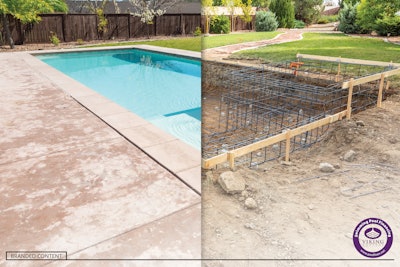
Since the Great Recession of 2008-09, interest rates for first mortgages fell from around 7% to about 2.75% over a 12-year period. But they’ve been climbing again since late 2020, which is making would-be pool owners cautious, which in turn is making pool builders nervous.
Greg Powell’s advice to both groups? Don’t worry.
“Based on the lenders that I talk with, I get the sense that they don’t see another rate hike coming at any point in the near future. Before, over the past two years, they knew rates would be raised every few months. Things have calmed down now,” says the founder and president of Viking Capital Inc., a Ponte Vedra Beach, Fla.-based company established in 1999 that acts in the capacity of “consultant” to pair lenders and pool buyers nationwide with the best swimming pool financing options available.
Viking Capital partners with pool builders to offer unsecured pool loans at lower interest rates than customers likely would pay through a traditional bank loan. Unlike an unsecured personal loan that can be used for any purpose, unsecured pool loans are designed specifically for financing major home remodels, renovations and swimming pools, and they usually are reserved for projects that cost more than $25,000. They offer desirable rates and extended loan terms up to 20 years, which means borrowers will have affordable monthly payments.
These loans do not require property as loan collateral, either; lenders instead consider the borrower’s income and debt, but the borrower’s interest rate is based almost entirely on credit score. (Powell notes that credit ratings for approved borrowers typically begin in the high 600s, these days, slightly higher than in years past.)
“This kind of loan flies under the radar for the general public,” says Powell, a 30-year veteran of the home improvement lending industry. “[Buyers] talk to their bank, they talk to their credit union, and they find there aren’t a lot of options out there. So when they talk to a pool builder, they often don’t know that an unsecured pool loan even exists.”
.jpg)
Which creates new opportunities for pool builders to actively promote this type of favorable financing.
“If you don’t proactively sell this product and put customers in the hands of a professional swimming pool financing service, you run the risk of them calling their bank and getting turned down or calling their credit union and finding out the monthly payment will be gigantic. They’ll just assume there are no other options,” Powell says. “They’ll get denied, the payments will be too high, or they can’t get as much money as they want. Then they’ll think, ‘Well, we can’t get a pool.’ So they move on.”
Specialty loans like those offered by Viking Capital are designed to make both the customer and the builder happy. When a borrower is approved, the interest rate is locked in, and there is no penalty for refinancing or paying off a loan early. Builders, meanwhile, typically receive payments with a favorable draw schedule directly from the lender via wired funds throughout the project. No wonder Powell calls unsecured pools loans “the best pool financing option out there.”
‘MORE IMPORTANT NOW THAN EVER BEFORE’
With interest rates high but holding relatively steady, Powell says its critical for pool builders and buyers to make a clear distinction between what happened in the late 2000s and what took place in the wake of the pandemic.
“There was a mortgage meltdown in 2008, with all those variable-rate mortgages. Nobody was putting any money down on their homes,” Powell says. “The high foreclosure rates stemmed from adjustable rate mortgages adjusting to rates that people couldn’t pay.”
On the other hand, the “slow, purposeful raising of rates” over the past couple years was intended to curb post-COVID inflation, which Powell believes has been successful. Interest rate hikes likely are coming to an end soon (if they haven’t already), and variable rate options might begin showing up in the market as a way to shield lenders from any future rate uncertainties.

Powell also believes the time for panicking caused by rising interest rates has passed. “Builders are getting a double whammy right now,” he says. “Not only did rates go up, but the industry is coming out of COVID, when builders sold so many pools. I think some pool builders thought that was going to last forever. And now they’re back to where they were pre-COVID, which is a much lower volume of pools than they were selling before. Had it just been interest rates trickling up and no COVID — just a steady stream of pools like they’ve always built — I don’t know that they would have really noticed or even cared.”
But because things didn’t happen that way, and because some cautious customers continue to put off big-ticket home improvement purchases, offering unsecured loans available from Viking Capital makes a lot of sense. Many builders promote financing using the free printed and digital flyers provided by Viking, as well as include a link on their websites to the custom, co-branded loan application they receive from Viking.
Builders not affiliated with Viking can fill out a “partner network” application online. Qualified builders must be licensed and insured, undergo background checks and be in business for at least one year, Powell notes, adding that all partners are subject to a review every six to 12 months. Other factors Viking considers when vetting builder partners include online presence, customer reviews and financial stability. This is because Viking advocates for its builder partners to ensure they get paid on time for the work they have completed.
“I genuinely believe that it’s more important now than ever before that builders have a good financing partner,” Powell concludes. “Because you will be losing deals if you let your customers fend for themselves.”




















